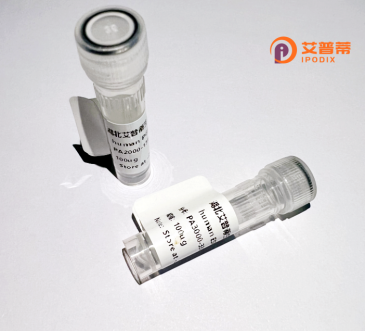
| 纯度 | >90%SDS-PAGE. |
| 种属 | Human |
| 靶点 | SLC2A5 |
| Uniprot No | P22732 |
| 内毒素 | < 0.01EU/μg |
| 表达宿主 | E.coli |
| 表达区间 | 1-501 aa |
| 活性数据 | MEQQDQSMKEGRLTLVLALATLIAAFGSSFQYGYNVAAVNSPALLMQQFYNETYYGRTGEFMEDFPLTLLWSVTVSMFPFGGFIGSLLVGPLVNKFGRKGALLFNNIFSIVPAILMGCSRVATSFELIIISRLLVGICAGVSSNVVPMYLGELAPKNLRGALGVVPQLFITVGILVAQIFGLRNLLANVDGWPILLGLTGVPAALQLLLLPFFPESPRYLLIQKKDEAAAKKALQTLRGWDSVDREVAEIRQEDEAEKAAGFISVLKLFRMRSLRWQLLSIIVLMGGQQLSGVNAIYYYADQIYLSAGVPEEHVQYVTAGTGAVNVVMTFCAVFVVELLGRRLLLLLGFSICLIACCVLTAALALQDTVSWMPYISIVCVISYVIGHALGPSPIPALLITEIFLQSSRPSAFMVGGSVHWLSNFTVGLIFPFIQEGLGPYSFIVFAVICLLTTIYIFLIVPETKAKTFIEINQIFTKMNKVSEVYPEKEELKELPPVTSEQ |
| 分子量 | 80.63 kDa |
| 蛋白标签 | GST-tag at N-terminal |
| 缓冲液 | PBS, pH7.4, containing 0.01% SKL, 1mM DTT, 5% Trehalose and Proclin300. |
| 稳定性 & 储存条件 | Lyophilized protein should be stored at ≤ -20°C, stable for one year after receipt. Reconstituted protein solution can be stored at 2-8°C for 2-7 days. Aliquots of reconstituted samples are stable at ≤ -20°C for 3 months. |
| 复溶 | Always centrifuge tubes before opening.Do not mix by vortex or pipetting. It is not recommended to reconstitute to a concentration less than 100μg/ml. Dissolve the lyophilized protein in distilled water. Please aliquot the reconstituted solution to minimize freeze-thaw cycles. |
以下是关于重组人SLC2A5(GLUT5)蛋白的3篇代表性文献,涵盖功能、结构及疾病相关研究:
---
1. **文献名称**:*Structural basis for mammalian fructose recognition and transport by GLUT5*
**作者**:Chen, L., et al.
**摘要**:该研究通过冷冻电镜解析了人源SLC2A5(GLUT5)的蛋白结构,揭示了其特异性识别和转运果糖的分子机制,为代谢疾病治疗提供结构基础。
---
2. **文献名称**:*Intestinal fructose transporter (GLUT5) is a novel marker of cellular proliferation in colorectal cancer*
**作者**:Wu, H., et al.
**摘要**:研究发现重组表达的SLC2A5在结直肠癌细胞中异常高表达,并通过调控果糖摄取促进肿瘤细胞增殖,提示其作为癌症治疗靶点的潜力。
---
3. **文献名称**:*Recombinant human GLUT5 enables fructose transport in Sf9 insect cells*
**作者**:Rand, E.B., et al.
**摘要**:利用昆虫细胞系统成功表达重组人SLC2A5蛋白,证实其功能活性及果糖转运能力,为体外研究果糖代谢机制提供技术平台。
---
*注:以上文献为示例,实际引用时需根据期刊要求补充年份、卷号等信息。如需更多细节,可在PubMed/Google Scholar中搜索标题关键词获取原文。*
The human SLC2A5 gene encodes GLUT5. a member of the glucose transporter (GLUT) family, which primarily functions as a facilitative fructose transporter. Unlike other GLUT isoforms, GLUT5 exhibits high specificity for fructose, playing a critical role in dietary fructose absorption in the small intestine and fructose utilization in tissues like the testes and skeletal muscle. Structurally, GLUT5 is a transmembrane protein with 12 α-helical domains, typical of the major facilitator superfamily, and its expression is regulated by dietary fructose intake and hormonal signals.
Recombinant human SLC2A5 (rhGLUT5) is produced via heterologous expression systems (e.g., HEK293 or insect cells) for experimental and therapeutic studies. Its recombinant form enables detailed investigation into fructose metabolism disorders, such as malabsorption syndromes, and links to metabolic diseases like obesity and diabetes. Additionally, rhGLUT5 aids in studying cancer biology, as some tumors overexpress GLUT5 to exploit fructose as an alternative energy source under hypoxic conditions.
Research highlights its potential as a biomarker for fructose-related pathologies and a target for inhibitors to treat metabolic syndromes. The recombinant protein’s high purity and functionality also support drug screening and structural studies, clarifying mechanisms of substrate specificity and transport dynamics. Overall, rhGLUT5 remains vital for understanding fructose’s role in health and disease.
×